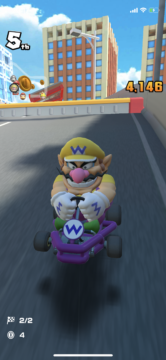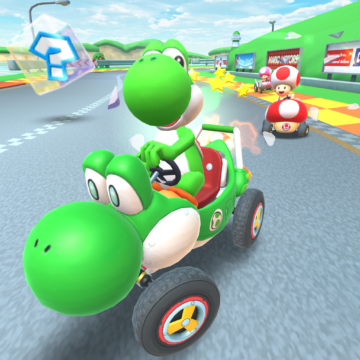Faithful transition of the familiar Mario Kart mechanics to mobile; can be played with one hand; lots of characters and courses; burst gameplay sessions are perfect for experiencing on the go
Controls can sometimes miss taps and swipes; spirit of Mario Kart is violated by monetizing every single racer, kart, and glider; leveling up is needlessly convoluted
As Mario Kart Tour first began trickling out to the public, a question I kept seeing on social media was, “who is this game for?” The unspoken caveat to that question being, “this doesn’t seem like it’s for me, so who is it for?” “Me” operatively standing in for the core gamer, of whom many fans consider themselves to be by virtue of being part of the Mario Kart community, which has been growing for the past 27 years since the launch of Super Mario Kart. Mario Kart Tour, in the eyes of some, is set apart from the “true” Mario Kart experience because of its nature as a mobile title, thus making it “other,” thus making it of dubious worth.
While it might pain some people to read this, those who consider themselves part of that elite world of the “core gamer” will likely not find Mario Kart Tour very welcoming. Most probably because the answer to that question of who Mario Kart Tour is for is, well… not you. Not the hardcore, not the vested, not the unwavering longtime fan. I consider myself to be a member of that cluster of gamers, and while I can acknowledge that Tour is for an audience separate from the one I identify with, it’s nonetheless a worthwhile experience that any fan should give a shot.
Mario Kart Tour is a miraculous distillation of the core mechanics of the series into mobile form. To finally answer the question of “who” Tour is being aimed at, the answer is the casual mobile crowd. We’ll get into how monetization works in this game, but for anyone that has played through a “free-to-start” mobile title, Mario Kart Tour isn’t all that different, which is going to be enough to alienate more than a few core gamers. Indeed, right off the bat Tour wears its mobile influences on its sleeve with only a single racer made available to players.

Racers, karts, and gliders must all be earned via unlock. Like many other aspects of Mario Kart Tour, this change is fairly drastic compared to the mainline entries of the series. That’s not the only way in which Tour differs greatly, as game progression is also massively altered compared to any prior Mario Kart. Here’s a basic breakdown of how it works:
- Placement in races isn’t as important as how many points the player earns
- Every course offers between three and five Grand Stars that are granted depending on how many points are earned in a race
- Every action in a race bestows points: boost, powerslide, gather coins, etc.
- Each racer, kart, and glider has its own point value that is added to the overall tally at the end of a race
- Every course has specific racers, karts, and gliders that can offer a maximum buff which will multiply point accumulation up to three times the base value

The key takeaway here is that coming in first is now a secondary goal. Earning Grand Stars allows players to progress through the multiple cups on offer (which rotate periodically); between racking up points and completing daily challenges, there are a number of opportunities for players to get their hands on these stars. In this regard, Tour is especially catering to the non-core crowd by allowing a means of moving forward that isn’t dependent on being best. At the same time, however, it’s a concession that also makes collecting racers, gliders, and karts more critical.
When I review games, I make a qualitative assessment; meaning, I weigh the merits of a given title based on its quality, not its value. How much a game costs, be it a flat dollar amount or a system of monetization, isn’t an indicator of quality, so I don’t think it’s right to factor pricing into a review score. That said, if the cost or means of monetization interfere with the gameplay in any way, that’s when I’ll take price into consideration. With Mario Kart Tour, Nintendo is pulling off quite the trapeze act to avoid making its monetization a problem.

What I’ve come to find is that, overall, Tour can be played and enjoyed without paying a cent. I’m currently at Player Level 20 and have earned first place in ranked races two weeks in a row, all without shelling out any real-world cash. There are two currencies in Tour: the first is Rubies, which allow players to unlock characters, karts, and gliders, and can also be exchanged for the secondary currency, coins. Coins in turn are used to buy drivers and their accompanying racing equipment outright in the in-game shop. Ruby acquisitions are handled “gacha” style, meaning rewards are given out blindly— and with no guarantee that players will get any specific item or racer that they want.
Again, insofar as mobile titles go this is pretty standard stuff, but for Mario Kart lifers this can all be jarring and frustrating. After all, half the fun of Mario Kart is experimenting with different drivers and finding the right one(s), mixing karts and tires and gliders to create the best combination to complement a player’s racing style, and so on. Yet, in Tour all of that is an afterthought. There’s little to no emphasis placed on the individuality of a given character. Instead, everyone is split into three tiers that impact their point value. Even if players are able to gather their favorite combo of racer and gear, different races favor different, random combinations of the three, making it practically impossible to stick to any single set of driver, glider, and kart.

Another new addition in Tour is the ability to level up racers, gliders, and karts. Every race nets experience points for all three, and there are also tickets which can be used to more rapidly level up a specific item or character. Leveling can feel rewarding at first, but it can quickly begin to feel overwhelming as more content is unlocked. Players can very suddenly find themselves with multiple racers and karts and gliders to trick out, with all bestowing different buffs to utilize during races. It’s not the hardest setup to master, but there’s definitely a learning curve to tackle in order to understand how everything functions (and interconnects). It works counterintuitively to the pick-up-and-play nature of Nintendo’s best games.
Where Tour further frustrates is that in one moment it can seem like the only way to advance is by paying for Ruby packs, but then in the next it turns out that what the player has already freely earned is actually enough, instead. For those with the patience, it’s entirely possible to wait and have Tour freely reward all of the coins and Rubies needed to level up and be competitive in any race. Yet, with so much locked behind pay walls of one kind or another, it can be disheartening to see cool character and kart variants available in the shop and not being able to play with them without forking over real cash.

To be fair, as a free-to-play game, it’s not like there’s an entry fee to start playing Mario Kart Tour. If Nintendo wants a few bucks to access some of the more exclusive content in the game, it’s hard to be upset when it’s 1) optional and 2) there’s no limit to how much Tour can be played. At a certain point in a single 24-hour window experience, points and coins stop being handed out, but Player Level can almost always be added to, and players can also attack their high scores without impediment, so Tour is never too guilty of artificially stymying player progress. At the same time, there’s something undeniably unsavory about seeing beloved characters like Shy Guy and Mario sold off piecemeal like scrap at a junkyard.
In terms of controls, it’s an absolute wonder that Tour handles as well as it does. The screen is oriented vertically and players can opt for touch or gyro controls, both of which can be fine-tuned in settings to better suit a player’s skill level. Acceleration is automatic, leaving players to focus on steering and item deployment. When it works, racing is sublime, but there are plenty of times when the game seems to lose track of the swipes and taps of the player. Even playing on an iPhone XS I’m not able to avoid these pratfalls. Visually, this is easily one of the prettiest titles on mobile. Animations are smooth, the framerate never dips, and the new real world-inspired tracks like Tokyo are gorgeous. It stinks that races are only two laps in Mario Kart Tour, as it gives little time to take in and enjoy the scenery.

Ultimately, Mario Kart Tour is going to be divisive because people will invariably want it to be something it’s not. Tour is a mobile game for casual and mobile-centric gamers— period. Its monetization is aggressive but completely avoidable. While I’m outspoken against the way that developers have been turning to microtransactions and “games as a service,” I’m also of the opinion that the only reason these models exist is because consumers refuse to stop supporting them. So, if Mario Kart Tour isn’t the sort of game for you… don’t download it. Otherwise, this is a serviceable take on the series that is marred by finicky controls and convoluted player progression.
Note on the Gold Pass: Those who fork over $5 a month can become a “Gold Pass subscriber” of Mario Kart Tour. All this does is offer a bunch of free Rubies and other goodies at sign-up, and after that players earn more rewards with each new milestone they hit while going through the various cups and leveling up. I can’t tell anyone how to spend their money, but I will say that what is given here in exchange for what is paid does not seem proportional. It only slightly speeds up progression; the fastest way is to buy bundles of Rubies. Outside of some color variants, this is a shallow extra.




 ShareThis
ShareThis






Those who fork over $5 a month can become a “Gold Pass subscriber” of Mario Kart Tour. All this does is offer a bunch of free Rubies and other goodies at sign-up, and after that players earn more rewards with each new milestone they hit while going through the various cups and leveling up. I can’t tell anyone how to spend their money, but I will say that what is given here in exchange for what is paid does not seem proportional. It only slightly speeds up progression; the fastest way is to buy bundles of Rubies. Outside of some color variants, this is a shallow extra.